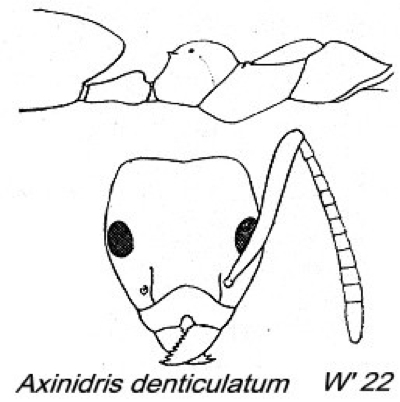Axinidris denticulatum (Wheeler)
  Type location Zaïre (Engramma
denticulatum, Wheeler, 1922: 205, illustrated, worker); holotype
and one other worker collected from firewood; two others from swollen
stems of Cuviera spp at Masaki, collected by Lang & Chapin
- no images on Antweb (February 2015) Type location Zaïre (Engramma
denticulatum, Wheeler, 1922: 205, illustrated, worker); holotype
and one other worker collected from firewood; two others from swollen
stems of Cuviera spp at Masaki, collected by Lang & Chapin
- no images on Antweb (February 2015)  . .
|
 Wheeler's
description (1922) is at Wheeler's
description (1922) is at  .
.
WORKER - Length 2.6 mm. Head subhexagonal, a little longer than broad
and slightly broader behind than in front, with the sides subangulate
in the middle and the posterior border feebly concave. Eyes moderately
large, near the middle of the sides. Mandibles rather small, convex,
with three large apical and several small basal teeth. Clypeal notch
small, semicircular, less than one-fifth as long as the anterior
border, with sharp corners. Frontal area indistinct; frontal groove
obsolete, Antennal scapes extending somewhat farther than their
greatest diameter beyond the posterior corners of the head; first
funicular joint as long as the two succeeding joints together; joints 2
to 7 about one and one-half times as long as broad, joints 8 to 10
slightly longer than broad. Thorax long, with very deep and broad
metanotal constriction so that it is dumbbell-shaped, the pronotum and
mesonotum convex and hemispherical above, the impression bearing the
prominent metathoracic spiracles, the propodeum high and convex like
the promesonotum, with two blunt denticles and prominent spiracles.
Petiole stout, through the distinct node-like thickening at its
anterior end nearly half as high as long. Gaster shaped as in the other
species of the genus, with the first segment overlying the petiole;
anus terminal. Shining; head and clypeus finely but distinctly
longitudinally aciculate; mandibles smooth, with coarse, scattered
punctures; pronotum finely and indistinctly punctate; mesonotum and
propodeum opaque, densely and rather coarsely punctate; gaster finely
reticulate. Pilosity and pubescence very sparse, the latter distinct
only on the appendages. Deep castaneous, nearly black; apical portions
of mandibles, bases of scapes, terminal tarsal joints and petiole
yellowish.
Described from two specimens taken by Lang and Chapin
between Lukolela and Basoko on firewood. Two imperfectly preserved
specimens were taken by Bequaert at Masaki, between Masisi and
Walikale, from the caulinary swellings of a Cuviera, (probably C.
angolensis) (Bequaert, 1922, p 492). This is a very strongly marked
species on account of the peculiar shape of the thorax, the two
denticles of the propodeum, and the peculiar sculpture of the head and
thorax.
|
 WORKER
- HL 0.79, HW 0.71, SL 0.62, PW 0.37 (Shattuck,
1991) WORKER
- HL 0.79, HW 0.71, SL 0.62, PW 0.37 (Shattuck,
1991)
Propodeal spines directed posteriorly with the area between them flat.
There seems to be a clear difference between the
specimen illustrated in Wheeler (1922, above) and the
illustration in Shattuck (1991, right). Shattuck commented that
he had studied only the syntype workers but did not remark on the
disparity in illustrations.
|